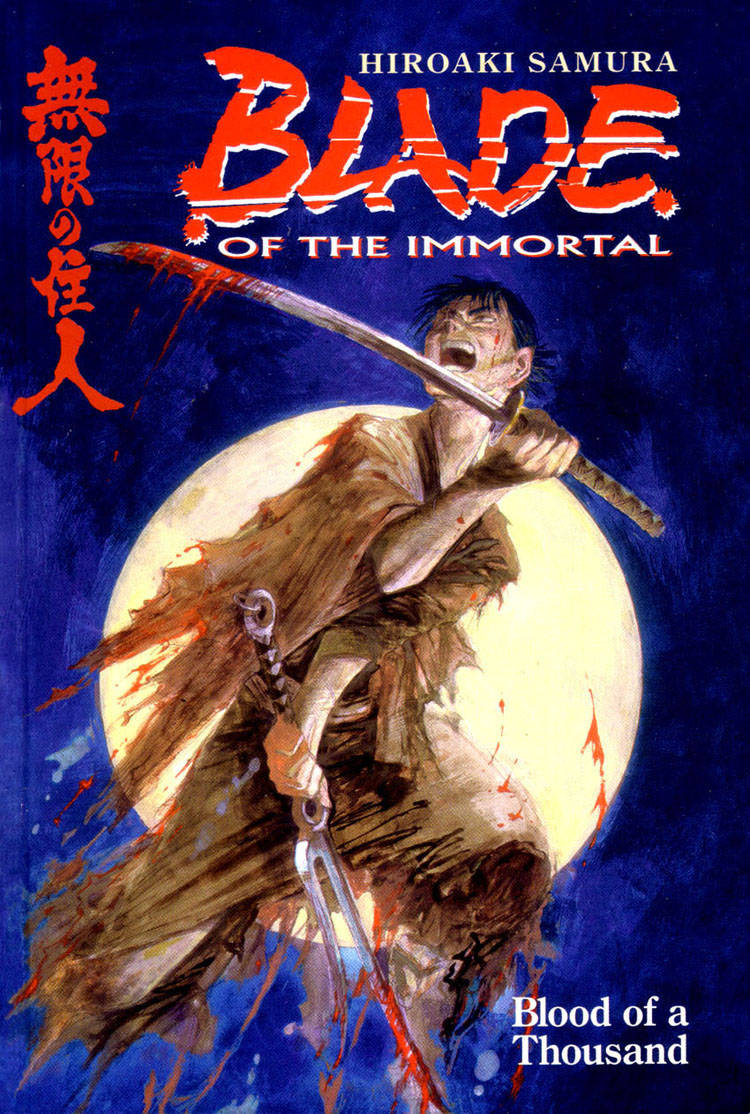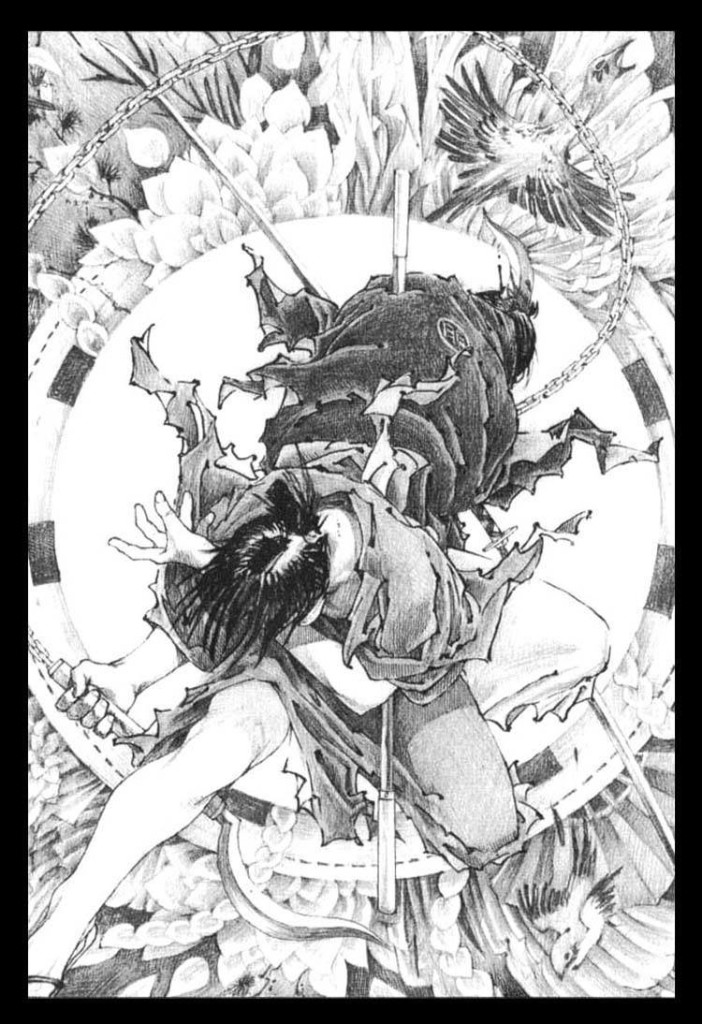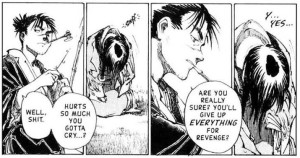Fantasy Manga 101: Blade of the Immortal
Glenn Hough (gallyangel) is a nonpracticing futurist, an anime and manga otaku, and is almost obsessive about finishing several of the lists tracked on WWEnd. In this series on Fantasy Manga Glenn will provide an overview of the medium and the place of fantasy within it.
 When I started the SF Manga 101 blog, I said that the top three spots in SF where agreed upon; it was only a matter of differing opinion as to the pecking order. The situation in Fantasy is not as clear.
When I started the SF Manga 101 blog, I said that the top three spots in SF where agreed upon; it was only a matter of differing opinion as to the pecking order. The situation in Fantasy is not as clear.
The first question is how do you define Fantasy? What’s in? What’s out? Since most of these mangas can be defined in various ways, what’s the deciding factors as to how to classify them? And does it really matter that much? Good is good, right?
For the purpose of this new blog on Fantasy, I have to decide and I’m going with K.I.S.S. (Keep It Simple, Stupid). The manga in this Fantasy blog will be as close as possible to the motifs of High Fantasy. I’ll consider three factors: the technological level is not on par with our own. I’m thinking of the infamous medieval lite motif or even 18th to 19th century levels – that’s all fine. Swords have to be involved somewhere and/or magic. (Elves and/or Dwarfs score bonus points!) Some combination of those elements is the key. (Travel to alternative dimensions is also allowed.) So all the top contenders which would be contemporary fantasy or magical realism get shuffled over to the supernatural category. That’s just the way the line is drawn.
Now that the housekeeping is done, it’s time to start.
 When it comes to Fantasy Manga, Blade of the Immortal is a top five pick and some would argue it’s ranking should be number one. I can certainly appreciate that argument.
When it comes to Fantasy Manga, Blade of the Immortal is a top five pick and some would argue it’s ranking should be number one. I can certainly appreciate that argument.
In June of 1996, our dear friends over at Dark Horse did themselves and us, the reading public, a favor: they published the first english issue of Blade of the Immortal. Blade has been going on for so long that’s it seen the gradual swell of interest in manga go from a fistful of titles a month, to the high-water mark of dozens of titles every few months, and back down to the current levels. Blade first started as a comic book and was one of the very last holdouts to stay in comic book form when everything else had already made the switch to the translated takubon format. But even Blade succumbed to the changing American marketplace. As of this writing, Blade has reached the 27th English takubon, but don’t let that number scare you.
This is what Dark Horse has to say about Blade of the Immortal Vol. 1:
To end his immortal suffering, he must slay one thousand enemies! Manji, a ronin warrior of feudal Japan, has been cursed with immortality. To rid himself of this curse, to regain his mortality, and to end his life of misery, he must slay one thousand evil men! His quest begins when a young girl seeks his help in taking revenge on her parents’ killers . . . and his quest won’t end until the blood of a thousand has spilled!
 The Path of Revenge is never a straight line and yes, this is exactly what you’re thinking: a sword slashing, body count piling up, blood dripping, revenge driven, power-mad, iron willed, ambition lusting, insanity fueled, duty fulfilling, era changing kind of work. This work hits like a spray of arterial blood after the killing cut has landed.
The Path of Revenge is never a straight line and yes, this is exactly what you’re thinking: a sword slashing, body count piling up, blood dripping, revenge driven, power-mad, iron willed, ambition lusting, insanity fueled, duty fulfilling, era changing kind of work. This work hits like a spray of arterial blood after the killing cut has landed.
And yet, for all it’s gore and bloodshed, for all it’s violent intensity, it’s the human elements which make this story work so well.
Nothing in this manga is as simple as good vs. evil. Yes, there are very evil people, who do very evil things. And I’ve known otaku who root for their bloody demise, but that is not the heart of this story. The center is the relationship between Rin, that young girl mentioned in Dark Horse’s intro, and her effect on Manji, our bloody immortal.
 We must have no false conceptions going in about our two leads. Manji is a murderer and Rin would gladly become one if it meant that her parents’ death is avenged. (Rin is 15 by the way.) The problem is our conception of murder in our society. This is Japan of the mid Tokugawa Shogunate, which existed between 1600 to 1868. Murder is not an absolute wrong. It’s much more a matter of who’s doing it, who’s getting it, and what the circumstances are. Formal duels to the death were not even considered murder. They were occasions for a crowd to gather and watch: an entertainment. It’s one of the factors which makes Blade so appealing, these contests of prowess to the death. Talented individuals, killers all, standing against all comers, in a society where such things are not only tolerated but encouraged. The times had not yet changed.
We must have no false conceptions going in about our two leads. Manji is a murderer and Rin would gladly become one if it meant that her parents’ death is avenged. (Rin is 15 by the way.) The problem is our conception of murder in our society. This is Japan of the mid Tokugawa Shogunate, which existed between 1600 to 1868. Murder is not an absolute wrong. It’s much more a matter of who’s doing it, who’s getting it, and what the circumstances are. Formal duels to the death were not even considered murder. They were occasions for a crowd to gather and watch: an entertainment. It’s one of the factors which makes Blade so appealing, these contests of prowess to the death. Talented individuals, killers all, standing against all comers, in a society where such things are not only tolerated but encouraged. The times had not yet changed.
But Blade is not just fight scenes and blood. Blade is imbedded in the society and politics of the day, which fuel the things that happen. As we the reader, especially a western reader, begin to understand why Rin’s parents were murdered by members of the Itto-Ryu (a sword school), we see the individual actors at work within the context of their society. Rin’s parents were murdered for legitimate reasons, which gives rise to Rin’s desire for legitimate vengeance and essentially hiring a hit man to help her with it. All of it, legitimate actions within the established context of the society and story.
 I must admit that it’s been over a decade since I’d read the opening chapters of Blade. (And the artwork has definitely improved!) Anyway, seeing Rin and Manji again at the start of it all, drives home to me just how deeply this quest has effected them. And not in negative ways.
I must admit that it’s been over a decade since I’d read the opening chapters of Blade. (And the artwork has definitely improved!) Anyway, seeing Rin and Manji again at the start of it all, drives home to me just how deeply this quest has effected them. And not in negative ways.
Rin and Manji’s quest is a trial that forges and hones, rather than breaks. It polishes, rather than rends. Can we really say anything about Manji’s life when he meets up with members of the Itto-Ryu who killed Rin’s parents, which make him look positively pure-hearted in comparison? Not really. It’s much more likely that we start cheering for Manji.
Which is, of course, one of the points to the whole thing. One of the layers to this story is that of a fight manga. Another layer is that of a historical drama. It’s only pushed into the fantasy realm due to Manji’s Kessen-chu, the sacred bloodworms which make him functionally immortal. By the time we’re into the later books, Manji and Rin are immeshed in a web of assassins, artists, ninja, couriers, doctors, geisha, ronin, court officials, madmen, death row inmates, prostitutes, flunkies, and stone-cold killers, in which Rin’s initial desire for vengeance is like that one last snowflake that sets the avalanche in motion. And yet that tiny thread is still there, tying the whole thing together.
 Rin certainly has no idea what she’s starting by hiring Manji as her bodyguard, to help her in her quest for vengeance. It’s been a long road for the reader, almost 20 years, even though only a handful of years have passed for Rin and Manji in the story. I’ve enjoyed every minute and look forward to the concluding chapters which have already been published in Japan.
Rin certainly has no idea what she’s starting by hiring Manji as her bodyguard, to help her in her quest for vengeance. It’s been a long road for the reader, almost 20 years, even though only a handful of years have passed for Rin and Manji in the story. I’ve enjoyed every minute and look forward to the concluding chapters which have already been published in Japan.
Blade of the Immortal by Hiroaki Samura is brought to the states by our friends at Dark Horse. It’s in print and obtainable from the secondary markets. Dark Horse is also converting Blade to a digital download as well. Mangatraders.com, mangahere.com, and mangapanda.com all have archived digital copies if you need a free version or get so into it that you have to read ahead, since their version is concurrent with the Japanese release schedule.



















 Full Details
Full Details


No comments yet.
Sorry, the comment form is closed at this time.